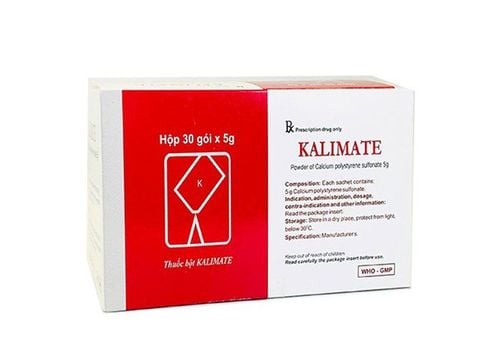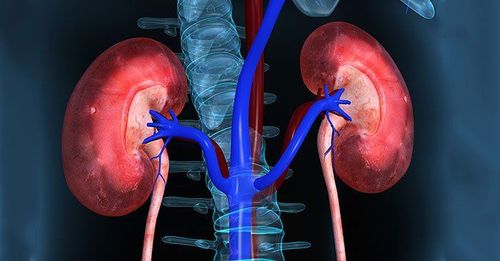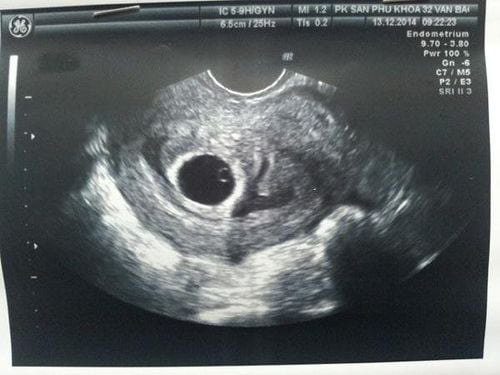This is an automatically translated article.
Article written by Pharmacist Hoang Nguyen Kim Thoa - Clinical Pharmacist, Faculty of Pharmacy - Vinmec Times City International Hospital
The total amount of potassium stored in the body is about 3000 mEq (50-70 mEq/kg body weight), concentrated mainly in the cells (140 mEq/L). In blood and extracellular fluid, normal potassium levels are 3.5–5 mEq/L. That is the value of potassium measured in a blood test. Hypokalemia is considered to be decreased when the serum potassium level is <3.5 mEg/L (mmol/l). Blood potassium is considered elevated when the serum potassium level is >5 mEq/L (mmol/l). Regulates potassium levels in the body through two processes: intracellular potassium exchange - extracellular fluid and renal excretion of potassium.
1. Drugs that can cause dyskalemia
Drug-induced hypokalemia, possibly due to increased urinary potassium excretion, is most common in patients receiving diuretics (especially furosemide) without potassium supplementation. In addition, some drugs can cause hypokalemia through increased excretion of potassium from the gastrointestinal tract (laxatives) or increased transport of potassium from the extracellular fluid into cells. Hypokalemia may appear earlier and be more severe in patients with high fever, profuse vomiting, diarrhea, or patients on a low-potassium diet.
Drug-induced hyperkalemia is quite rare in patients with normal renal function, the incidence is usually <10%. Drug-induced hyperkalemia is more common in patients with advanced age, impaired renal function, or concomitant use of multiple drugs that cause hyperkalemia. Drugs that cause hyperkalemia may be due to increased potassium intake, increased absorption of potassium, increased potassium transfer from cells to extracellular fluid, or decreased renal excretion of potassium.
| Các thuốc có thể gây tăng kali | Chỉ định điều trị chính |
| Acid amin truyền | Nuôi dưỡng tĩnh mạch, điều chỉnh tình trạng thiếu protein |
| Chế phẩm bổ sung kali | Hạ kali máu |
| Chẹn beta (Ví dụ: propranolol, bisoprolol, nebivolol, metoprolol, carvedilol…) | Bệnh mạch vành mạn tính, suy tim, tăng huyết áp, rối loạn nhịp tim |
|
Chẹn kênh calci (Thường gặp hơn ở verapamil) |
Tăng huyết áp, rối loạn nhịp tim |
| Digoxin | Suy tim, rung nhĩ |
| Lợi tiểu kháng aldosteron (lợi tiểu giữ kali) – spironolacton | Hội chứng tăng aldosteron tiên phát, suy tim, phù, cổ chướng, tăng huyết áp |
| NSAID (Ví dụ: ibuprofen, diclofenac, celecoxib, etoricoxib…) | Giảm đau, chống viêm, hạ sốt |
| Trimetoprim | Nhiễm khuẩn |
| Ức chế calcineurin (tacrolimus, cyclosporin) | Ức chế miễn dịch – chống thải ghép sau ghép tạng |
|
Ức chế men chuyển (Ví dụ: perindopril, lisinopril, enalapril |
Tăng huyết áp, suy tim |
|
Ức chế thụ thể angiotensin (Ví dụ: losartan, telmisartan, valsartan, irbesartan) |
Tăng huyết áp, suy tim |
| Các thuốc có thể gây tăng kali | Chỉ định điều trị chính |
| Lợi tiểu (Ví dụ: furosemid, hydroclorothiazid) | Phù (do suy tim, xơ gan, suy thận, phù phổi cấp), tăng huyết áp |
| Cường beta giao cảm (Ví dụ: salbutamol) | Hen phế quản, bệnh phổi tắc nghẽn mạn tính |
| Dẫn chất xanthin (Ví dụ: theophylin, caffein) | Chậm nhịp tim, hen phế quản, bệnh phổi tắc nghẽn mạn tính |
| Amphotericin B | Điều trị nấm |
| Insulin | Tiểu đường |
| Corticoid (Ví dụ: methylprednisolon, prednisolon) | Chống viêm, chống dị ứng, ức chế miễn dịch |
2. Signs of drug-induced dyskalemia
Not all patients with dyskalemia have clinical manifestations.
Manifestations of hypokalemia may include myalgia, cramps, muscle weakness, persistent constipation, abdominal distension (neuromuscular sign), palpitations, palpitations, syncope (cardiovascular sign). Manifestations of hyperkalemia may include extremity or perioral paresthesias, numbness or tingling of the fingertips (neurological signs), palpitations, palpitations, and syncope (cardiovascular signs).

Ngất là biểu hiện hạ kali máu
3. How to deal with drug-induced dyskalemia?
Immediately go to a medical facility if there are symptoms of hyperkalemia or hypokalemiaMedical staff will evaluate the relationship between the drug and the state of hyperkalemia - hypokalemia to decide to stop the drug clinically and treat according to the level Severe In order to prevent drug-induced dyskalemia, do not arbitrarily use prescription drugs or arbitrarily prolong prescriptions without re-examination. Periodic health checkup (6 months/time in healthy people and 1-3 months/time in people with stable chronic diseases) and follow-up examination according to the doctor's appointment. Monitor for signs of hyperkalemia and hypokalemia if you are taking medications that can cause hyperkalemia or hypokalemia as advised by your doctor and pharmacist.

Dược sĩ tư vấn cách sử dụng thuốc an toàn
Please dial HOTLINE for more information or register for an appointment HERE. Download MyVinmec app to make appointments faster and to manage your bookings easily.













